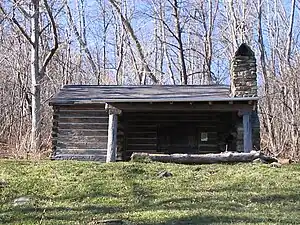Backcountry
In the United States, a backcountry or backwater is a geographical area that is remote, undeveloped, isolated, or difficult to access.[1]

Terminology
Backcountry and wilderness within United States national parks
The National Park Service (NPS) generally uses the term "backcountry" to refer to "primitive, undeveloped portions of parks". Developments within backcountry areas are generally limited to trails, unpaved roads, and administrative facilities associated with dispersed recreational use. Dispersed recreational use is the most prevalent human use in backcountry areas, although research activities may also occur.[1]
The NPS defines wilderness within US national parks as any "backcountry areas which have been specifically designated as part of the National Wilderness Preservation System or any other area that has been determined to possess the characteristics of wilderness as defined by Section 2(c) of the Wilderness Act".[1] Section 2(c) states in part that wilderness:
(1) generally appears to have been affected primarily by the forces of nature, with the imprint of man's work substantially unnoticeable; (2) has outstanding opportunities for solitude or a primitive and unconfined type of recreation; (3) has at least five thousand acres of land or is of sufficient size as to make practicable its preservation and use in an unimpaired condition; and (4) may also contain ecological, geological, or other features of scientific, educational, scenic, or historical value.[2]
Wilderness lands within US national parks are a subset of all backcountry lands.[3] Wilderness and backcountry lands also exist outside of US national parks on public lands managed by the US Forest Service, the Bureau of Land Management, and the US Fish and Wildlife Service.
Use of the term "backcountry" in New Zealand
In New Zealand, "backcountry" often refers to land that is not accessible by public access. For example, it is common for a farmer to have some remote parts of their land left in scrubland or forest. This is often adjacent to other areas of backcountry which are yet to be developed or protected from development. Trampers and other explorers sometimes need to get farmers' permission to access parts of the national parks of New Zealand or other natural phenomena, if they intend to pass over backcountry. Hunters can ask for permission from farmers to hunt in their backcountry.
Hazards
The backcountry contains many hazards including rough terrain, life-threatening weather, avalanches, and wild animals.[4] Tragic accidents and dramatic backcountry rescues of stranded hikers, climbers, or skiers are a staple of news reporting.[5]
Some jurisdictions have discussed placing limits on human access to the backcountry during times of particular danger.[6]
See also
References
- "NPS: Explore Nature » Reference Manual #77". www.nature.nps.gov. Archived from the original on 2018-05-12. Retrieved 2018-05-12.
- "Wilderness.net - 1964 Wilderness Act". Wilderness.net. Retrieved 2018-05-12.
- NPS Reference Manual 41. 2013.
Backcountry is not the same as wilderness. Rather, it refers to a general condition of land that may include wilderness.
- "More people dying in avalanches as more take to B.C.'s backcountry". Canada.com. December 30, 2008. Archived from the original on November 10, 2012. Retrieved July 6, 2011.
- "Stranded Backcountry Skier Is Rescued After Eight Days". The New York Times. April 26, 2005. Retrieved July 6, 2011.
- "Latest avalanche has Colorado looking at backcountry limits". The Bulletin. February 22, 1993. Retrieved July 6, 2011.